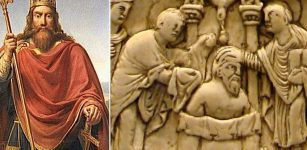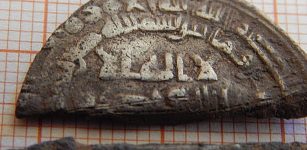Yokai Kijo (Kidjo): Demoness, Cannibal With Hideous Heart Is A Moral Reminder In Japanese Beliefs
A. Sutherland - AncientPages.com - The narratives surrounding the mythical female demons, known as 'kijo', carry a profound moral lesson: women who engage in unethical or immoral conduct risk transforming into malevolent entities that feast on humans.
Image credit: Adobe Stock - cegli 222
Kijo (or Kidjo) is a demoness, a cannibal woman usually wearing rags. In the beautiful beliefs of Japanese people, she is a yokai ("Yōkai") like thousands of other yokai figures.
The younger ones are called "kijo" while the ones that look like old ladies are called onibaba ("demon hag"). Kijo is usually huge but sometimes can be small. They are ugly; their appearance may vary; some of these monsters have (red or yellow eyes, blue skin, sharp horns, long claws, and dirty, matted hair.
These entities possess the extraordinary ability to shapeshift into alternative humanoid forms. As beautiful young ladies, they can be very dangerous trying to charm men. They also exhibit an insatiable craving for human flesh, which can be classified as an addiction. These beings are endowed with various supernatural characteristics that defy conventional understanding.
What did happen to these women?
Vengeful women turn into demons. According to Japanese folk tradition, women who have been betrayed by their husbands or abused or mistreated girls and grandmothers can turn into demons or monsters.
However, the term 'kijo' predominantly refers to females who have undergone a metamorphosis from human beings into monstrous entities, either as a consequence of committing terrible crimes, succumbing to uncontrollable and perilous jealousy, or harboring intense hatred and malice.
The print depicts the herione Kiyohime in distress on the banks of the Hidaka River. Chikanobu Toyohara, The Boatman, 1898. Triptych from the Bamboo Knots (Take no Hitofushi) series. Public Domain
Such highly negative feelings and actions influenced by them undoubtedly corrupt the pure soul. These individuals, having forsaken the rules of polite society, sought refuge in isolated dwellings such as abandoned residences or secluded mountain caverns or even made use of wandering along desolate roads under the veil of darkness.
This yokai's only goal is to continue committing evil deeds. Extremely powerful and dangerous, Kijo demonesses are skilled in the secrets of magic. They are highly capable of casting spells and brewing deadly poisons and potions.
Kijos do not act in groups. Instead, they prefer to act alone and are often driven by personal motives. Japanese legends say that they act either as persecutors of sinners in the underworld or as a threat to human society in the human world.
A particular moral lesson dominates in all stories about the Kijo demoness. It says that women who do bad things can become evil creatures, and men who follow them and succumb to their charm may ruin their lives or encounter their ultimate demise.
There are countless legends of Kijo female monsters in Japanese folklore. Most of them, however, were not created to scare people but as entertainment, warnings, or moral reminders.
Generally, 'Kijo' can be defined as a designation for any demonic or supernatural entity of the feminine gender with malevolent or otherworldly characteristics that can be found within various cultural traditions.
Section of the scroll Dojoji Engi Emaki illustrating the story where the serpent burns the bell killing the monk. Image credit: Unknown author - Dojo-ji engi emaki - Date : Muromachi period (16th) - Wakayama Prefecture, Japan. Public Domain
One of the most famous legends of Kijo demons in Japanese folklore is the tale of Kiyohime. According to this ancient narrative, Kiyohime was the daughter of Shaji, the respected leader of a village. Their family was popular and respected for extending hospitality to travelers passing through their community.
Kiyohime And Unreturned Love
The tale of Kiyohime and Monk Anchin explores the complexities of unreturned love.
Kiyohime, a village maiden, fell in love with a monk, Anchin, who once visited her village. The monk responded to Kiyohime's affections, but it was more on an aesthetic level, admiring her beauty.
Unfortunately, he did not want to pursue a deeper, more passionate connection with the girl. Driven by her intense emotions, Kiyohime decided to pursue the monk, which finally caused a tragic end.
Legend says that the monk escaped to the banks of the Hidaka River, begging the sailors to refrain from helping the girl cross the river. Kiyohime did not want to give up her pursuit. Consumed by her wrath, she decided to swim across the river herself. As she entered the currents, something extraordinary happened. Her fury manifested in a remarkable transformation, causing Kiyohime to assume the form of a serpent.
The monk Anchin saw this and took refuge in a temple, asking the temple to hide him in a bell. It did not help much. Kiyohime followed him and found the bell. Spitting fire through her mouth, she melted the bell and killed the monk. Kiyohime is considered a snake woman who kidnaps men in villages.
Written by – A. Sutherland - AncientPages.com Senior Staff Writer
Copyright © AncientPages.com All rights reserved. This material may not be published, broadcast, rewritten or redistributed in whole or part without thexpress written permission of AncientPages.com
More From Ancient Pages
-
 Burnt Mound Complex Dated To Bronze Age – Uncovered At Suffolk Site
Archaeology | Jun 19, 2023
Burnt Mound Complex Dated To Bronze Age – Uncovered At Suffolk Site
Archaeology | Jun 19, 2023 -
 Ullr – Famous Norse Archer – God Of Asgard And Fastest Skier Ever Known Who Taught People The Art
Featured Stories | Jan 10, 2020
Ullr – Famous Norse Archer – God Of Asgard And Fastest Skier Ever Known Who Taught People The Art
Featured Stories | Jan 10, 2020 -
 What Was Lex Salica?
Ancient History Facts | Dec 13, 2017
What Was Lex Salica?
Ancient History Facts | Dec 13, 2017 -
 Treasure Trove Of Arabic Coins Dated Back 1,000 Years Unearthed In Graveyard In Poland
Archaeology | Jul 9, 2019
Treasure Trove Of Arabic Coins Dated Back 1,000 Years Unearthed In Graveyard In Poland
Archaeology | Jul 9, 2019 -
 Exceptional Collection Of Well-Preserved Stucco Masks Of The Mayan Kingdom Reveal Their Secrets
Archaeology | Dec 5, 2022
Exceptional Collection Of Well-Preserved Stucco Masks Of The Mayan Kingdom Reveal Their Secrets
Archaeology | Dec 5, 2022 -
 Balbals – Ancient Stone Guards Of The Kazakh Steppe
Artifacts | Dec 21, 2015
Balbals – Ancient Stone Guards Of The Kazakh Steppe
Artifacts | Dec 21, 2015 -
 Oldest Greek Oracle At Dodona And Zeus Sacred Oak Tree – Where Oracle of Dodona: Sacred Place Where Gods Spoke To Humans For The First Time
Featured Stories | May 24, 2016
Oldest Greek Oracle At Dodona And Zeus Sacred Oak Tree – Where Oracle of Dodona: Sacred Place Where Gods Spoke To Humans For The First Time
Featured Stories | May 24, 2016 -
 Headless remains related to Huns or Sarmatians puzzle archaeologists in Kazakhstan
News | Aug 30, 2015
Headless remains related to Huns or Sarmatians puzzle archaeologists in Kazakhstan
News | Aug 30, 2015 -
 Biblical Events Confirmed: The Jerusalem’s Wall That Nehemiah Built
Biblical Mysteries | Mar 19, 2014
Biblical Events Confirmed: The Jerusalem’s Wall That Nehemiah Built
Biblical Mysteries | Mar 19, 2014 -
 Atacama Desert Reveals More Ancient Secrets
Archaeology | May 8, 2018
Atacama Desert Reveals More Ancient Secrets
Archaeology | May 8, 2018 -
 On This Day In History: Cyrus The Great Enters Capital Of Babylon And Allows Jews Return To Their Land – On Oct 29, 539 BC
News | Oct 29, 2016
On This Day In History: Cyrus The Great Enters Capital Of Babylon And Allows Jews Return To Their Land – On Oct 29, 539 BC
News | Oct 29, 2016 -
 Who Were The First Icelanders?
Archaeology | Jun 4, 2018
Who Were The First Icelanders?
Archaeology | Jun 4, 2018 -
 Early Christian Crypt Unearthed In Zaldapa Fortress, Bulgaria
News | Sep 7, 2015
Early Christian Crypt Unearthed In Zaldapa Fortress, Bulgaria
News | Sep 7, 2015 -
 Suomenlinna Fortress: Impressive ‘Castle Of Finland’ Has Rich History
Featured Stories | Feb 13, 2016
Suomenlinna Fortress: Impressive ‘Castle Of Finland’ Has Rich History
Featured Stories | Feb 13, 2016 -
 Ancient City Of Babylon Finally Declared A World Heritage Site By UNESCO
Archaeology | Jul 8, 2019
Ancient City Of Babylon Finally Declared A World Heritage Site By UNESCO
Archaeology | Jul 8, 2019 -
 Wasabi Plant Can Save Ancient Bio-Deteriorated Papyrus
Scripts, Paintings & Inscriptions | Apr 4, 2024
Wasabi Plant Can Save Ancient Bio-Deteriorated Papyrus
Scripts, Paintings & Inscriptions | Apr 4, 2024 -
 Mystery Of The Ancient Red Sign Witnessed In The Sky Over Japan
News | Mar 31, 2020
Mystery Of The Ancient Red Sign Witnessed In The Sky Over Japan
News | Mar 31, 2020 -
 On This Day In History: The Name Of America Used For The First Time On World Map – On Apr 25, 1507
News | Apr 25, 2016
On This Day In History: The Name Of America Used For The First Time On World Map – On Apr 25, 1507
News | Apr 25, 2016 -
 Cave 53 In Qumran Region In Judean Desert Reveals More Secrets
Archaeology | Feb 28, 2022
Cave 53 In Qumran Region In Judean Desert Reveals More Secrets
Archaeology | Feb 28, 2022 -
 Were The Viking Berserkers True Or Drug Addicted Warriors Fighting In Trance?
Featured Stories | Feb 3, 2015
Were The Viking Berserkers True Or Drug Addicted Warriors Fighting In Trance?
Featured Stories | Feb 3, 2015



